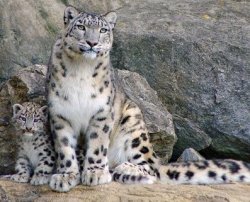 The condition of the snow leopard population in the south part of Shapshal ridge and on the Tsagaan-Shibetu ridge in Tuva is favorable, but the main menace to the irbis still comes from poachers.
The condition of the snow leopard population in the south part of Shapshal ridge and on the Tsagaan-Shibetu ridge in Tuva is favorable, but the main menace to the irbis still comes from poachers.
That is the conclusion reached by the experts of the expedition which took place with the support of the Altai-Sayan section of WWF after calculation of the numbers of snow leopard and mountain goat. The participants in the project, which ended on March 6, were workers of the "Ubsunur depression" preserve and inspectors from State Committee of Republic Tuva for Hunting and Fishing.
Evidence of irbis activity was found in all the observed river valleys - from the upper Khemchik and Shui, and also in the basins of rivers Toolaityg and Barlyk. 23 tracks were found, which, in the opinion of experts, belong to 15-17 leopards, and one visual sighting of this rare predator was registered.
"The snow leopard here breeds successfully, - concludes Alexander Kuksin, worker of the "Ubsunur depression" preserve. - We saw the tracks of two female irbis with young - one and two cubs. That means that the population of this predator is being successfully replenished by young irbises,, and in general, the condition of the snow leopard group in the south part of Shapshal ridge and on the Tsagaan-Shibetu ridge can be considered to be good. It can be estimated that the population of snow leopard has even increased a little during the period of 2004 - 2011, since in 2004 on the same territory 13 irbis tracks were registered, belonging to about 8-10 individuals."
Along with the tracks of the rare predator, the scientists also found many locations of repeated irbis marking activities; that means places, where the irbis, just like an ordinary cat, marks its territory. About 40 fecal samples were collected, which are believed to belong to irbis. This material will be sent by the specialists of the A. N. Severtsov Institute of problems of ecology and evolution of RAN (Moscow) for DNA analysis, which will allow to determine exactly the number of the animals, their sex and even their age. These fecal samples will also be useful for training the search-dog, whose preparation is being done with the support of WWF by an experienced cynologist in Barnaul. In the future, the German shepherd dog Erik, trained to search and recognize evidence of irbis activity by the smell, will be a great help to Tuvan and Altai naturalists in field work. Currently Erik trains with fecal material from the Zoo. Material from natural irbis habitat will allow the dog to greatly raise his competence, since he will eventually work in the real habitat of the predator.
Visually the scientists observed 148 individuals of Siberian mountain goat, which is an adequate number for the territory and period. This winter with scanty snowfall left the mountain goat grazing areas in high mountains bare; a large number of the goats remained there over the winter. Among other irbis prey species on the observed territory, maral, roe-deer, musk deer and Altai "ular".
Poaching still presents a special menace to the existence of irbis and its prey on the ridges Shapshal and Tsagaan-Shibetu. The inspectors of the Hunting and Fishing commission arrested three poachers from the Ovyur district during this expedition, who were illegally shooting mountain goats in the basin of Eldig-Khem river.
In winter, the poachers who trap animals with nooses, and who are involved in illegal musk deer hunting, live permanently on the upper Barlyk river. Every year, at least two or three irbises are lost because they accidentally get caught in the noose traps.
As the press-secretary of the Altai-Sayan section of WWF, Tatiana Ivanitskaya announced, an effective measure for protection of irbis in the south of Shapshal ridge and on the Tsagaan-Shibetu range could turn out to be development of eco-tourism,, with the participation of general local population, who could offer lodging for tourists, organize rentals and horses, and craft souvenirs for sale, as well as work as guides in the snow leopard habitat. The organization of nature park "Shuiskiy" in the south part of the Shapshal ridge should significantly boost the development of eco-tourism.
The victory of the snow leopard in the internet-voting of the contest of the main noteworthy attractions of Tuva "Tos Ertine" presents a reason to think that the use of an image of an irbis as an advertising symbol of Western Tuva is a good idea for development of educational, scientific and photo-tourism for Western Tuva - the natural home of the snow leopard.

